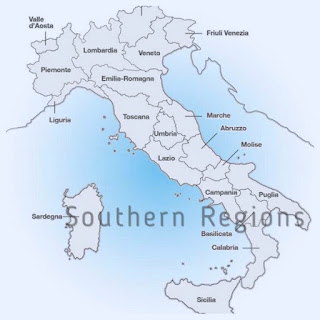 |
| Southern Italian Wine Regions |
Calabria
The wines from Calabria have been subject to many influences over the centuries, most notably that of the ancient Greeks, who cultivated the first wine-bearing vines here. |
| Castle of Scilla on the rock in Calabria |
Campania
Its name comes from Campania felix, a Latin phrase roughly meaning 'happy land' and is one of Italy's very oldest wine regions. |
| Amalfi coast in Campania |
The white-wine varieties include Fiano and Greco, which are used to produce the region's most respected white wines.
Puglia
Virtually all of Puglia's most interesting wines are red and produced in the southern part of the area designated IGT Salento.Land here is relatively flat and incessantly hot, so there is no great variation in climate across different vineyards.
 |
| Unique Trulli houses with conical roofs in Alberobellodd Puglia |
Primitivo di Manduria is one of Puglia’s most popular and enjoyable red wines. It is said to be a relative of California's Zinfandel.
Sardinia (Sardegna)
Sardinia which is off the west coast of mainland Italy is the second-largest island in the Mediterranean Sea.Wine has never played an important part in Sardinian culture or agriculture and the region has been noticeably slower to join the international modern wine-making industry.
 |
| Relitto beach in Sardinia |
Cannonau, the local form of Spanish Garnacha (Grenache) is a popular red grape varietal from this region. Similarly the Spanish Carignano grape performs well, with some excellent wines emerging from the DOC of Carignano del Sulcis in the South West.
Vermentino di Sardegna is a more commercially available wine from this region made from the Vermentino white grape.
Perhaps Sardinia’s most unique wine, is the Vernaccia di Oristano produced in Oristano, in a method similar to the Spanish fortified wine Fino Sherry.
Red varieties Monica and Girò and white Nuragus Nasco are Sardinian grapes of more obscure origin. Nuragus which is an ancient vine, is thought to have been brought to Sardinia by the Phoenicians in the 12th century BC.
Sicily
Sicily is Italy's southernmost region, and the largest island in the Mediterranean Sea. Blessed with consistently bright sunshine and reliably moderate rainfall, Sicily's classic Mediterranean climate is ideally suited for growing wine grapes. |
| Trapani town and harbor in Sicily |
Marsala a fortified wine, commonly used for cooking comes from Sicily.
References
The World Atlas of WineArticle Category: Drinks




No comments